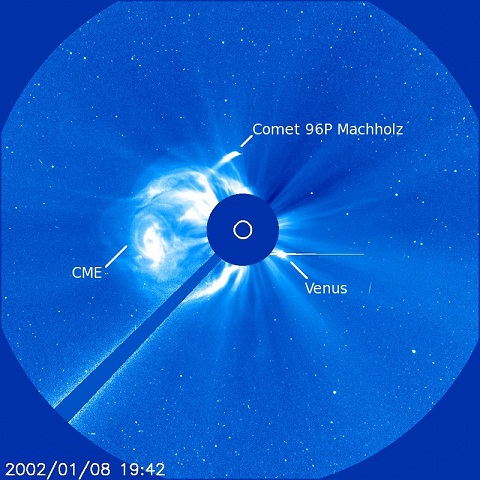While it took Soho about a decade to discover the first thousand comets with the help of amateur astronomers, the growing storm of comets in the solar region meant that the next thousand took only five years to discover

On December 26, the SOHO spacecraft - an acronym for the Solar and Heliospheric Observatory - discovered the XNUMXth comet.
With the help of amateur astronomers around the world, Soho became the greatest single comet discoverer of all time. This is impressive because Soho was not designed at all to catch comets but to monitor the Sun.
"Since it was launched on December 2, 1995, the spacecraft has more than doubled the number of comets that were known in the last three hundred years," says Joe Gorman, a scientist in the American part of the SOHO project at the Goddard Space Flight Center in Maryland.
Of course, it was not Soho herself who discovered the comets, but the joint work of dozens of amateur astronomers who passed daily on dancing images produced by LASCO (wide-angle spectromagnetic chromatograph) cameras. Over 70 people from 18 different countries helped locate the comet over the past 15 years by digging through publicly available data on the Internet.
Comets 1999 and 2000 were discovered on December 26 by Michal Kosiak, an astronomy student at the Jaglonian University in Krakow, Poland. Kosiak found his first comet in the SoHo photo archive in November 2007 and has since discovered over a hundred.
"A lot of people do," says Carl Bettams, who has been in charge of the Soho Internet Observations Project since 2003 for the Naval Research Laboratories in Washington, where he performs computer processing of the LASCO images. "They do it for free, they are very dedicated and without their help most of the materials would not see the light of day."
Batams receives reports from people who believe they have seen one of the dots in the LASCO images that appears to be the right size and brightness, and which is in front of the Sun – a typical feature of the comets Soho discovers. He confirms the findings by giving each comet an unofficial number, then sends the information to the Minor Planet Center in Cambridge, Massachusetts, which characterizes the small astronomical bodies and their orbits.
It took Soho over a decade to discover the thousand comet but only five more years to discover a thousand more. This was done due to the increased participation of comet hunters who optimize the work of observing comets, as well as due to a significant increase in the number of comets near the Sun. In fact, in December alone, 37 new comets were discovered, which can be described as a comet storm.
LASCO was not designed to observe comets. The camera hides the bright part of the Sun in order to better detect pale emissions from the Sun's outer atmosphere - or corona. LASCO's detection skills are a natural byproduct - when the sun is blocked, it is easier to see blind objects such as comets.
"But there is a lot more science that comes with these comets" Batams says. "First, we now know that there are many more comets in the inner solar system than we were aware of until now, and that this can tell us a lot about how comets were formed and how they decay. We have information on a lot of comets and they all have a common source" In fact, Batams says, 85% of the comets discovered by LASCO come from one group known as the Kreutz Group, which is believed to be the remnant of a single comet that broke up several hundred years ago.
Comets from the Kreutz family are solar comets, those whose orbits bring them so close to the Sun that most of them evaporate within hours of discovery - but many others make a boomerang orbit around the Sun and become periodic comets. One of the frequent visitors is comet 96P Machholz which orbits the Sun about once every six years and has been observed by Soho three times.
Soho is a joint venture of the European Space Agency ESA and NASA. The spacecraft was built in Europe and equipped with scientific instruments in the US and Europe.
